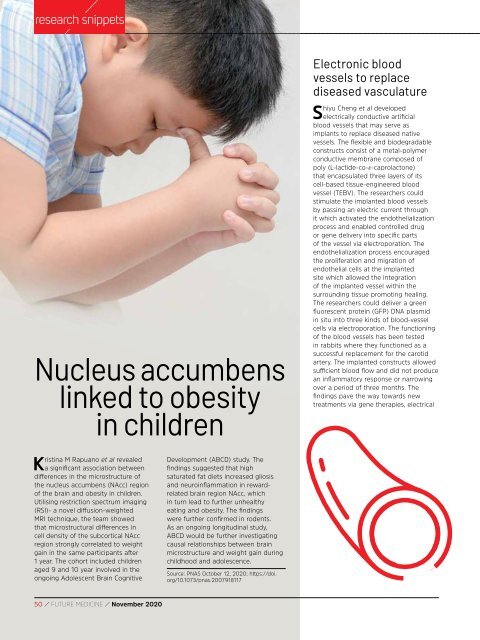FM November2020 Digital P
Create successful ePaper yourself
Turn your PDF publications into a flip-book with our unique Google optimized e-Paper software.
esearch snippets<br />
Nucleus accumbens<br />
linked to obesity<br />
in children<br />
Electronic blood<br />
vessels to replace<br />
diseased vasculature<br />
Shiyu Cheng et al developed<br />
electrically conductive artificial<br />
blood vessels that may serve as<br />
implants to replace diseased native<br />
vessels. The flexible and biodegradable<br />
constructs consist of a metal-polymer<br />
conductive membrane composed of<br />
poly (L-lactide-co-ε-caprolactone)<br />
that encapsulated three layers of its<br />
cell-based tissue-engineered blood<br />
vessel (TEBV). The researchers could<br />
stimulate the implanted blood vessels<br />
by passing an electric current through<br />
it which activated the endothelialization<br />
process and enabled controlled drug<br />
or gene delivery into specific parts<br />
of the vessel via electroporation. The<br />
endothelialization process encouraged<br />
the proliferation and migration of<br />
endothelial cells at the implanted<br />
site which allowed the integration<br />
of the implanted vessel within the<br />
surrounding tissue promoting healing.<br />
The researchers could deliver a green<br />
fluorescent protein (GFP) DNA plasmid<br />
in situ into three kinds of blood-vessel<br />
cells via electroporation. The functioning<br />
of the blood vessels has been tested<br />
in rabbits where they functioned as a<br />
successful replacement for the carotid<br />
artery. The implanted constructs allowed<br />
sufficient blood flow and did not produce<br />
an inflammatory response or narrowing<br />
over a period of three months. The<br />
findings pave the way towards new<br />
treatments via gene therapies, electrical<br />
Kristina M Rapuano et al revealed<br />
a significant association between<br />
differences in the microstructure of<br />
the nucleus accumbens (NAcc) region<br />
of the brain and obesity in children.<br />
Utilising restriction spectrum imaging<br />
(RSI)- a novel diffusion-weighted<br />
MRI technique, the team showed<br />
that microstructural differences in<br />
cell density of the subcortical NAcc<br />
region strongly correlated to weight<br />
gain in the same participants after<br />
1 year. The cohort included children<br />
aged 9 and 10 year involved in the<br />
ongoing Adolescent Brain Cognitive<br />
Development (ABCD) study. The<br />
findings suggested that high<br />
saturated fat diets increased gliosis<br />
and neuroinflammation in rewardrelated<br />
brain region NAcc, which<br />
in turn lead to further unhealthy<br />
eating and obesity. The findings<br />
were further confirmed in rodents.<br />
As an ongoing longitudinal study,<br />
ABCD would be further investigating<br />
causal relationships between brain<br />
microstructure and weight gain during<br />
childhood and adolescence.<br />
Source: PNAS October 12, 2020; https://doi.<br />
org/10.1073/pnas.2007918117<br />
50 / FUTURE MEDICINE / November 2020

















